This story was produced in partnership with Grist and is co-published with ICT.
In any given year, thousands of people are incarcerated in dozens of detention facilities run by tribal nations or the Bureau of Indian Affairs. Often left out of research on climate and carceral facilities, the tribal prisoner population is one of the most invisible and vulnerable in the country.
Now, climate change threatens to make matters worse.
According to a Grist analysis, more than half of all tribal facilities could see at least 50 days per year in temperatures above 90 degrees Fahrenheit by the end of the century if emissions continue to grow at their current pace. Ten facilities could experience more than 150 days of this kind of heat. Yet many tribal detention centers do not have the infrastructure, or funding, to endure such extreme temperatures for that long. This kind of heat exposure is especially dangerous for those with preexisting conditions like high blood pressure, which Indigenous people are more likely to have than white people.
“Tribal court jails are the worst jails in the country. They’re worse than any facilities you’ll ever go to,” said Diego Urbina, a public defender for the Pueblo of Laguna. “I worked at a [veterinary] hospital when I was 15 years old, and the vet hospital had better facilities than we have out here.”
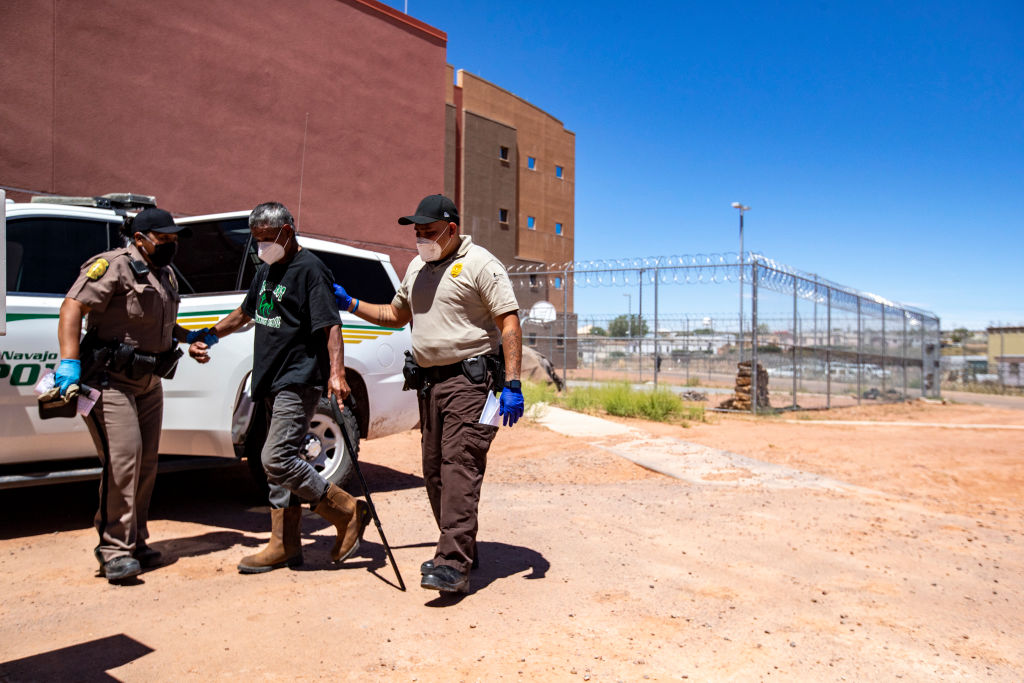
A Navajo Nation police officer and a corrections officer take a person into custody at the jail facility on the Navajo Reservation on May 22, 2020, in Tuba City, Arizona. Image: Brian van der Brug/Los Angeles Times via Getty Images
In the Pueblo of Laguna jail, just 45 minutes west of Albuquerque, New Mexico, the air conditioner was often down, according to Brandon Chavez, a Laguna citizen who has been detained multiple times over the past few years. Even when doors were left open for cross ventilation, the effort did little to blunt the hot desert air, Chavez said.
“Climate change and excessive heat factors into Pueblo planning for all aspects of Laguna government and the Laguna community,” officials from the Pueblo of Laguna wrote in an email to Grist and Type Investigations. When asked whether Laguna currently has plans to manage climate impacts like excessive heat, officials wrote, “The [detention facility’s] HVAC system is less than 10 years old and normally keeps the occupants warm in the colder months and cool in the hotter months. Malfunctions will occasionally happen and are quickly repaired.”

Image: J.D. Reeves/Grist
While New Mexico’s Cibola County rarely sees a heat index over 90 degrees, both Chavez and Urbina said that the Laguna Tribal Detention Center, located there, can be unbearably hot. And temperatures are only expected to go up: According to data from the Union of Concerned Scientists, Cibola County — and the Laguna jail — could see about 50 days per year above 90 degrees by the end of the century if emissions and temperatures continue to rise at their current pace, a drastic change from the present day.
According to Chavez, the Laguna jail is already a grim place. “There was literally pipes exposed,” said Chavez. “There was mold on places, and we used to tell [the guards]. They didn’t care. I’ve been into some pretty huge jails around some places, and nothing still compares to the mistreatment [at] my Pueblo jail.”
Urbina said his clients detained in the jail have complained about backed-up toilets, overdue repairs, and overcrowding, including having to share a shower with 20-plus other people. “At one time, they packed that thing like sardines,” Urbina said of the Laguna jail.
In response, James Burson, an in-house attorney for the Pueblo of Laguna, told Grist and Type that a renovation of showers, toilets, and sinks in the facility was completed in February 2022.
Tribes have their own justice systems, including courts, law enforcement, jails, and prisons. In a given year, thousands of people are incarcerated in these detention facilities. In 2021, more than half of those detainees were held for nonviolent offenses, and a majority had not been convicted of a crime.
Tribal jails have a long history of mismanagement. In 2004, the Department of Interior, which oversees the Bureau of Indian Affairs, issued a report that called the state of tribal jails a “national disgrace.” It examined everything from deaths in facilities, attempted suicides, and escapes — serious incidents that were not reported to supervisors 98 percent of the time — to smaller issues including broken lights, malfunctioning cameras, faulty plumbing, and leaking water pumps. “Nothing less than a Herculean effort to turn these conditions around would be morally acceptable,” investigators wrote at the time.
In the aftermath of the report, funding for facilities increased, the percentage of certified officers grew, and new jails were built. However, multiple reports and investigations over the years have shown that little else has changed since 2004. According to an NPR report in June 2021, at least 19 people had died in tribal detention centers since 2016, while one out of five correctional officers had not completed required basic training. Reporters also highlighted facilities with broken pipes, dirty water, and other infrastructure problems.
“Under Interior’s new leadership, we are seeking increased funding and conducting a comprehensive review of law enforcement policies, practices and resources to ensure that [Bureau of Indian Affairs] detention center staff are adequately trained, that our facilities are upgraded, and that we respect the rights and dignity of those within our system to the fullest extent,” Darryl LaCounte, the director of the Bureau of Indian Affairs, or BIA, said in a written statement to NPR at the time.
In an April report, the Office of Inspector General, or OIG, highlighted serious health and safety concerns at three tribal detention facilities: San Carlos Apache Adult/Juvenile Detention Center, the White Mountain Apache Adult Detention Center, and the Tohono O’odham Adult Detention Facility. The report comes as part of an ongoing performance audit of BIA-funded or BIA-operated detention programs, and says that the problems identified need immediate attention. Issues include holes in walls, broken air-conditioning, nonoperational toilets and sinks, and moldy shower ceilings. Many of those challenges were also included in a 2016 OIG report.
“The safety issues raised in this report are disturbing enough on their own, but the fact that they span multiple administrations is inexcusable,” U.S. Representative Raúl M. Grijalva, a ranking member of the House Natural Resources Committee, said in a statement on the recent report.
In 2022, The Intercept assessed the growing risk of extreme heat in jails and prisons across the United States. But of the roughly 6,500 facilities The Intercept analyzed, only 16 were tribal detention centers and jails, excluding the vast majority of tribal facilities across the country. Grist and Type Investigations built on The Intercept’s reporting to fill this gap.
Based on an analysis from the Union of Concerned Scientists, information collected via Freedom of Information Act, or FOIA, requests from the BIA, and research conducted in partnership with the Carceral Ecologies Lab at the University of California, Los Angeles, we tracked heat risk for 81 tribal jails and prisons spread across 20 states.
In 2019, the Union of Concerned Scientists published a county-by-county analysis of just how hot the contiguous U.S. could become under different levels of global climate action, from rapid action to reduce global emissions to effectively no action. The researchers then looked at the heat index, or the “feels like” temperature, which takes both humidity and air temperature into account, to paint a holistic picture of how heat would actually be experienced by communities on the ground. The National Weather Service also uses the heat index when issuing advisories or excessive heat warnings.
The researchers found that by mid-century, under a no-action scenario, “the average number of days per year with a heat index above 100°F will more than double, while the number of days per year above 105°F will quadruple.” In other words, in just a few decades, dangerous heat will become much more commonplace unless aggressive action is taken to limit climate change.
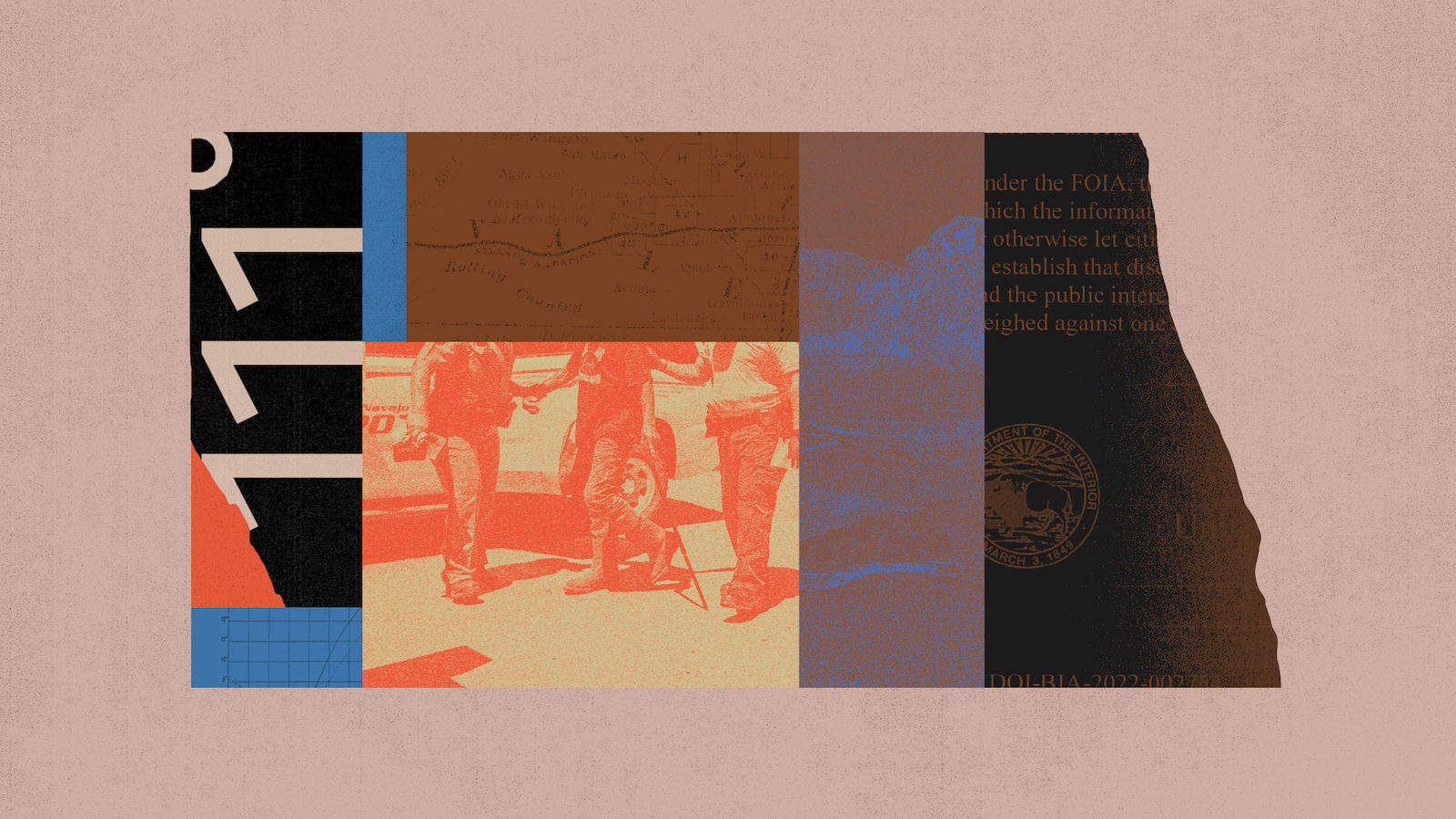
Image: J.D. Reeves/Grist
Jails across the country already face challenges when it comes to managing heat. The Intercept’s analysis found that “hundreds of thousands of incarcerated people are being subjected to prolonged periods of high heat every year.” Tribal jails are no different.
According to information Grist obtained through FOIA, most tribal facilities are in the Western U.S., where climates tend to be arid or hot. Nearly 20 percent of tribal facilities already face more than 50 days per year with a heat index above 90 degrees — the point at which heatstroke and heat exhaustion become much greater risks, particularly for vulnerable groups, such as elderly and obese people, and those with preexisting health conditions.
Within 80 years, if emissions continue to grow at their current rate, three out of four tribal facilities could experience 50 days or more in those temperatures.
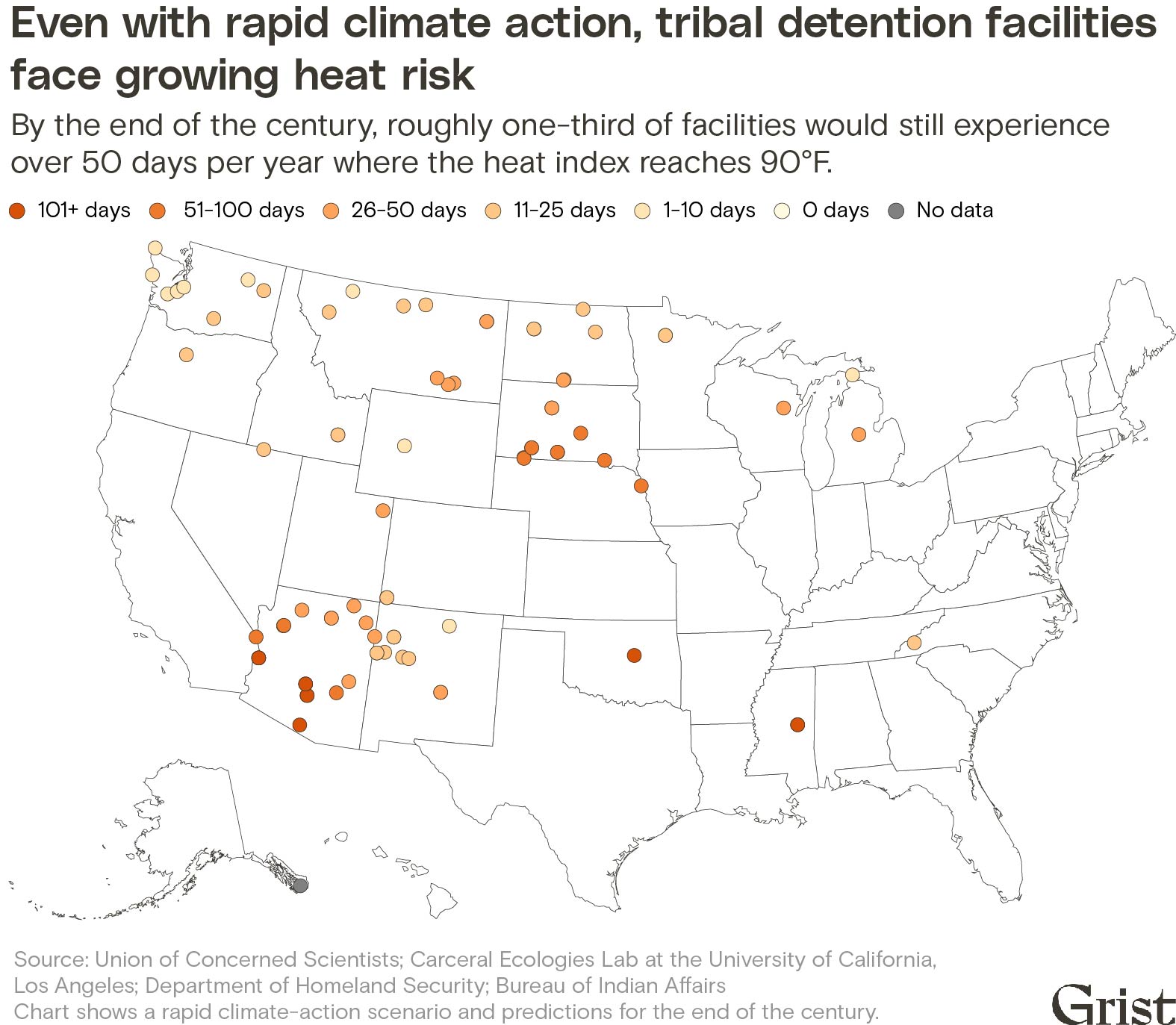
Image: Jessie Blaeser/Grist
Hundred-degree temperatures are a key marker for the National Weather Service. Generally, heat advisories are issued once the heat index reaches 100 degrees for 48 hours. Just five tribal facilities typically experience more than 50 days per year where the heat index tops 100 degrees F. But at the world’s current rate of emissions growth, that number will more than triple by the end of the century, with 17 tribal facilities experiencing 50 or more days per year where the heat index tops 100 degrees. Places like the Colorado River Indian Tribes Female Adult Detention Center and the Salt River Pima-Maricopa Department of Corrections Juvenile facility, located in Parker and Scottsdale, Arizona, respectively, could experience well over 100 days per year in 100-degree heat.
In states not historically considered “hot,” like Montana, Idaho, or Washington, tribal detention facilities could also see dramatic increases in excessive heat, according to Grist’s analysis. Facilities typically accustomed to experiencing only a day or two of temperatures above 90 degrees could see up to 24 days per year where the heat index tops 90, just within the next few decades.
“That ramp-up from zero to 10 [days out of the year] — that’s really significant for places where the infrastructure is less prepared,” said Kristina Dahl, the principal climate scientist for the Union of Concerned Scientists’ climate and energy program. “Generally, in any given year, heat kills more people in the U.S. than any other hazard like a hurricane, a flood, tornadoes, etc.”
Dahl and her fellow researchers have called for aggressive action to limit global warming, but for some communities in the U.S., more frequent extreme heat is inevitable.
Even if world leaders take rapid action to curb global temperature rise and reach goals set by the 2015 Paris Agreement, the number of tribal jails and detention centers experiencing more than 50 days over 90 degrees could increase by roughly 70 percent by the end of the century.
The Union of Concerned Scientists used statistical models to predict the number of days each county in the contiguous United States would experience temperatures above 90, 100, and 105 degrees F by the end of the century. But a county’s risk of experiencing extreme heat can change, depending on the degree to which world leaders are able to lower fossil fuel emissions and stop global warming.
A “rapid action” scenario represents the fulfillment of the goals set forth in the Paris climate accord, or limiting temperature rise to 3.6 degrees F above preindustrial temperatures.
Under the “slow action” scenario, greenhouse gas emissions will have declined by mid-century and temperature rise would be limited to roughly 4.3 degrees F by the start of the next century. Scientists consider this scenario to be the most likely.
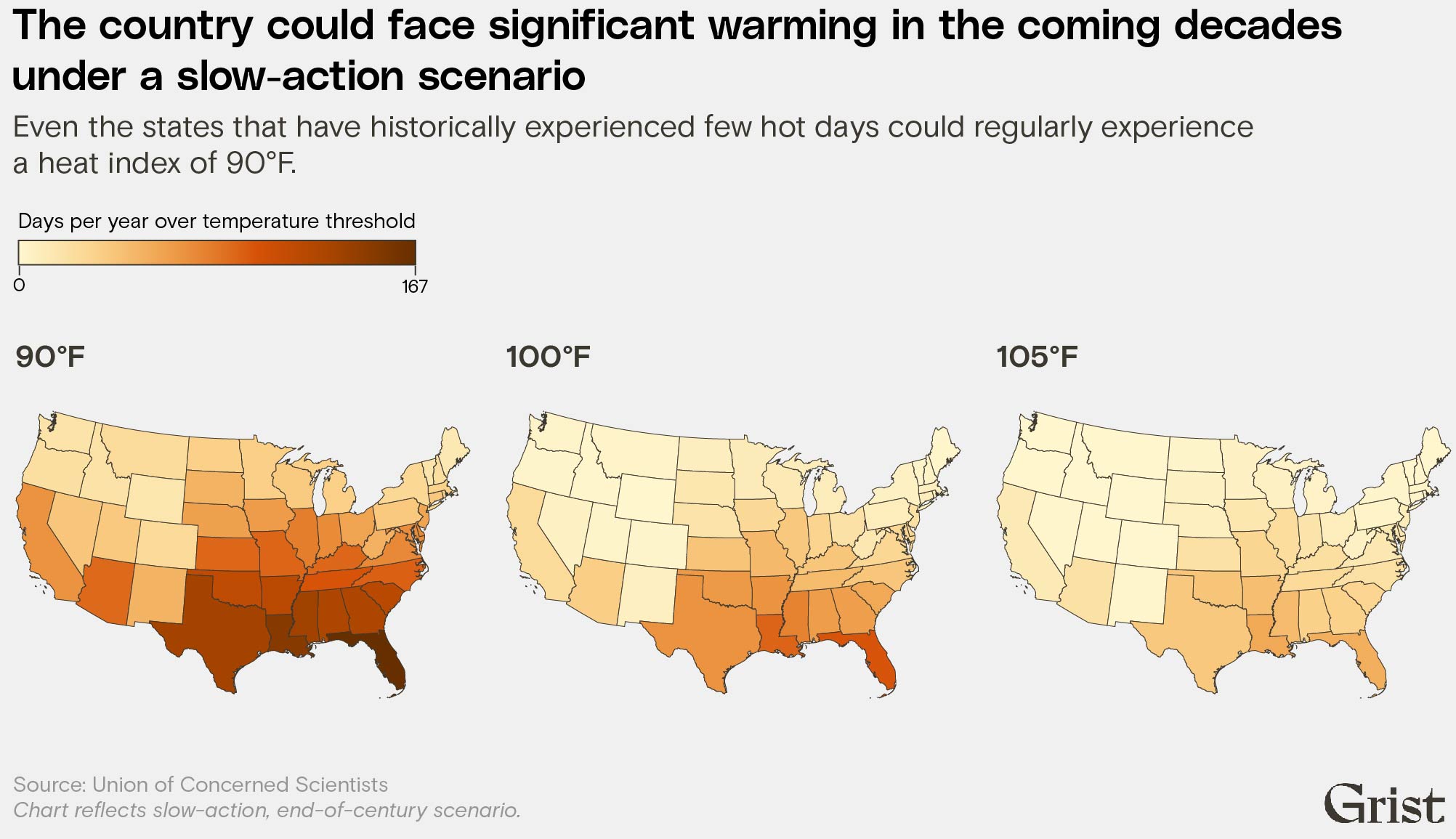
Image: Jessie Blaeser/Grist
According to Grist’s analysis — which combines Union of Concerned Scientists’ data with information on detention center locations obtained via FOIA requests — under this scenario, roughly one-third of tribal facilities would see more than 50 days per year with a heat index reaching at least 90 degrees F.
Roughly 14 percent would see more than 50 days with a heat index topping 100 degrees F.
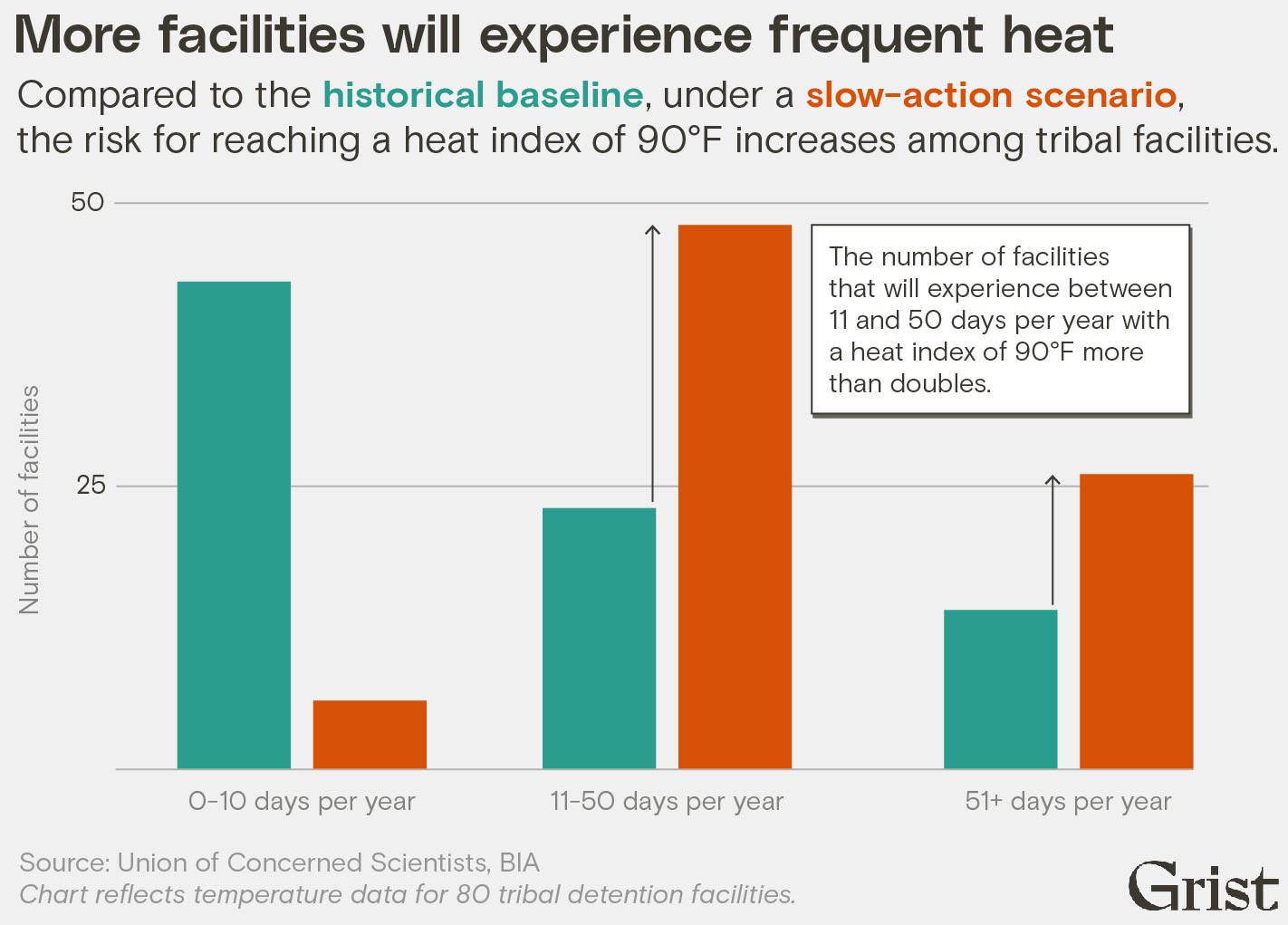
Image: Jessie Blaeser/Grist
One of the biggest hurdles to understanding and addressing the heat risks tribal facilities face is gathering even the most basic information about them.
The Bureau of Indian Affairs places tribal corrections facilities into four categories: direct, 638, self-governance, and tribal. Direct means the facility is run directly by the BIA; there are 23 of these programs. Meanwhile, 638 programs, which receive BIA funding but are contracted out to tribes to operate, make up roughly half of all facilities, according to BIA documents. Self-governance facilities can also receive federal funding and allow tribes more control. Tribal facilities are run and funded directly by tribes themselves.
The U.S. Department of Homeland Security publishes hundreds of datasets related to critical infrastructure for public use. Among them is a database containing addresses for over 6,700 correctional institutions in the United States. Of these records, only 16 are tribal facilities, representing less than 20 percent of tribal detention centers in operation.
The BIA does not make publicly available the exact number and locations of many tribal jails and detention centers, including the physical address of the jail at Pueblo of Laguna — Department of Interior Secretary Deb Haaland’s home community. In an email to Grist and Type, a BIA spokesperson attributed this lack of transparency to “security reasons.” When asked to explain the nature of these security concerns, BIA did not expand, but instead wrote in an email that tribes are “not required to report address changes to the BIA.” The agency added that it provides oversight, including onsite visits to monitor compliance with federal standards.
Last year, Grist filed a Freedom of Information Act request for the specific locations of all tribal detention facilities, including those previously kept private by the Bureau of Indian Affairs. The BIA released the locations of 23 active detention centers managed by the agency, but withheld the addresses of tribally operated detention centers. Those include 638, self-governance, and tribal facilities.
A second FOIA request for these locations revealed only the cities in which these facilities are located, and no street or mailing addresses. The Salt River Pima-Maricopa Department of Corrections juvenile and adult facilities, for instance, are located in “Scottsdale, AZ,” but where those centers are in the city’s roughly 185 square miles was not revealed. Grist has appealed the agency’s response.
Grist partnered with the Carceral Ecologies Lab at the University of California, Los Angeles, to begin answering these questions.
The U.S. Department of Justice tracks information about the population in tribal jails through the Annual Survey of Jails in Indian Country. According to its midyear surveys from 2010 to 2019, an average of 70 percent of tribal jail detainees were held for nonviolent offenses. By midyear 2021, that percentage had dropped slightly to roughly 60 percent of detainees. According to the Justice Department, the average length of stay for a tribal detainee in 2021 was roughly 11 days, with 53 percent of those held in these facilities that year having not been convicted of a crime.
Heating and cooling are common problems in tribal jails, according to tribal public defenders, who also said water quality, bathroom maintenance, overcrowding, and staff training are of concern.
Those conditions can make incarcerated people, as well as those who work at carceral facilities, more susceptible to health risks associated with extreme heat. Preexisting conditions such as asthma, hypertension, and obesity can increase susceptibility to heatstroke and heart attack.
“[Incarcerated people] have limited mobility and suffer from a disproportionate amount of mental health and medical comorbidities that are exacerbated by exposure to extreme temperatures,” environmental epidemiologist Julianne Skarha and her coauthors wrote in a 2020 paper in the American Journal of Public Health assessing the health effects of extreme heat among incarcerated populations.
There is limited research on the intersection of extreme temperatures and carceral facilities, and in research Grist reviewed, tribal jails were not included.
However, between 1988 and 2019, Skarha and her team inspected at least 100 legal cases citing violations of the Eighth Amendment — that no imprisoned person can be subject to “cruel and unusual punishment” — based on exposure to extreme temperatures. In Texas alone, Skarha found that approximately 270 heat-related deaths occurred between 2001 and 2019 in carceral facilities that do not have air-conditioning. Yet no national database tracks air-conditioning availability in jails, let alone tribal jails.
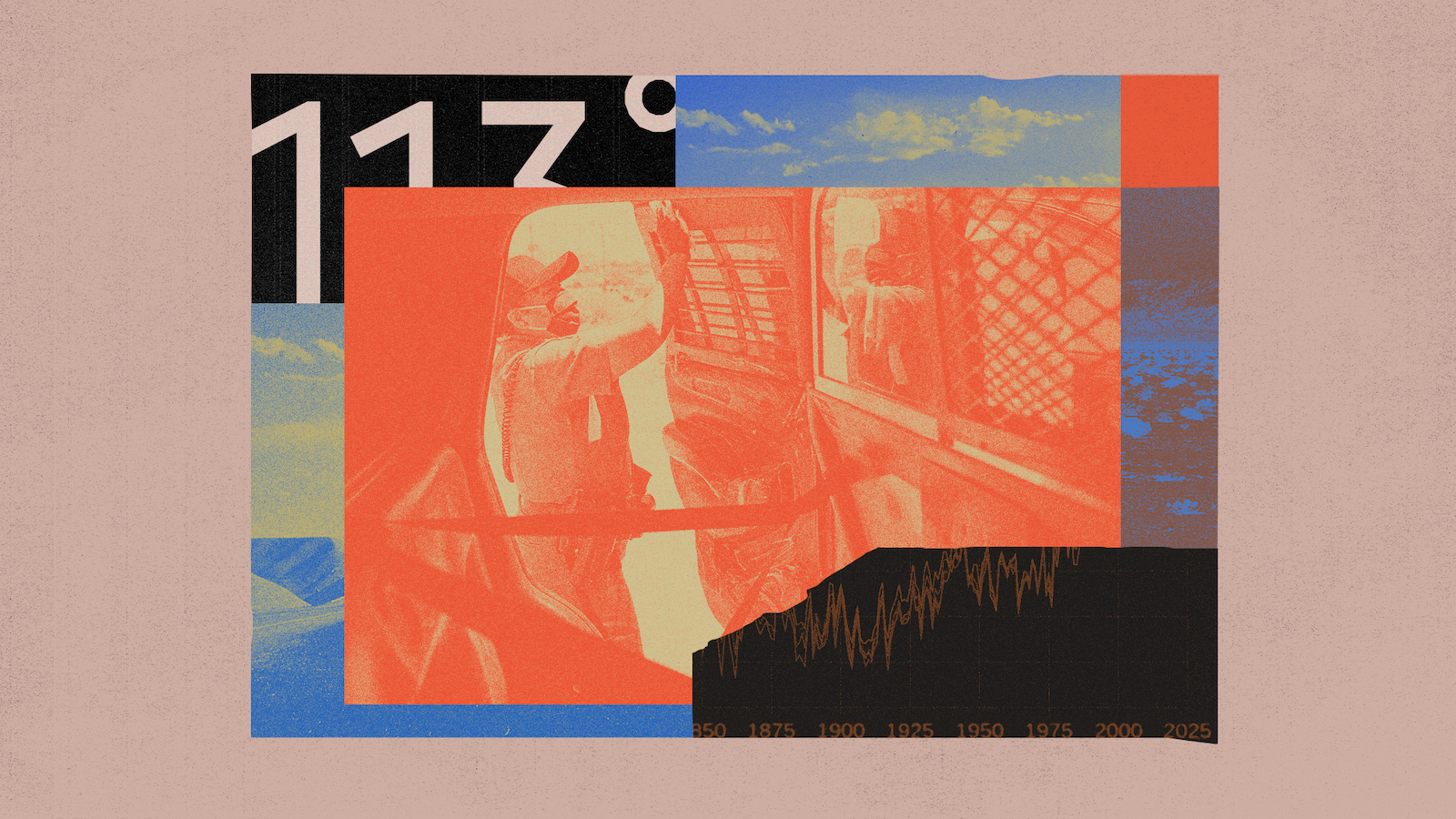
Image: J.D. Reeves/Grist
In Arizona, one of the hottest states in the country, three tribes have seven facilities that face the greatest risk for excessive heat among tribal jails. These facilities include the Colorado River Indian Tribes’ male, female, and juvenile detention centers, and adult and juvenile centers for the Salt River Pima-Maricopa Indian Community’s Department of Corrections and the Gila River Department of Corrections.
The Salt River Pima-Maricopa Indian Community Department of Corrections adult and juvenile facilities are located in Maricopa County. Last summer, temperatures in Maricopa County reached a high of 115 degrees, with the National Weather Service issuing 17 heat warnings for the Phoenix area in 2022. As of October 2022, the total number of heat-associated deaths in the county reached nearly 380 — up at least 50 percent from the same month in 2021.
“As a tribe, we’re starting to realize climate change,” said Wi-Bwa Grey, a member of the Salt River Pima-Maricopa Indian Community tribal council. “We’re in the desert, where the sun hits us the most. Now, leadership, our council, is starting to really take that into consideration.”
About a four-hour drive northeast of Salt River, the Zuni Pueblo adult and juvenile detention facilities in McKinley County, New Mexico, have historically seen very few days where the heat index tops 90 degrees. But by the end of the century, Zuni Pueblo could experience more than roughly 55 days a year with temperatures above 90 degrees if emissions continue at their current rate, representing a massive change to the area’s typical climate.
Tyler Lastiyano, Zuni Pueblo’s director of public safety, said the Zuni jail, a 638 facility, recently updated its HVAC system. To deal with rising temperatures and higher energy costs, he hopes that the facility can transition to renewable energy. “If we can get the funding to do that, it’ll help us in the long run,” he said. For now, however, Lastiyano has to make trade-offs.
“Our tribal government can help. They can advocate, and they have advocated, but it’s the Bureau [of Indian Affairs] that has to approve our funding,” he said.
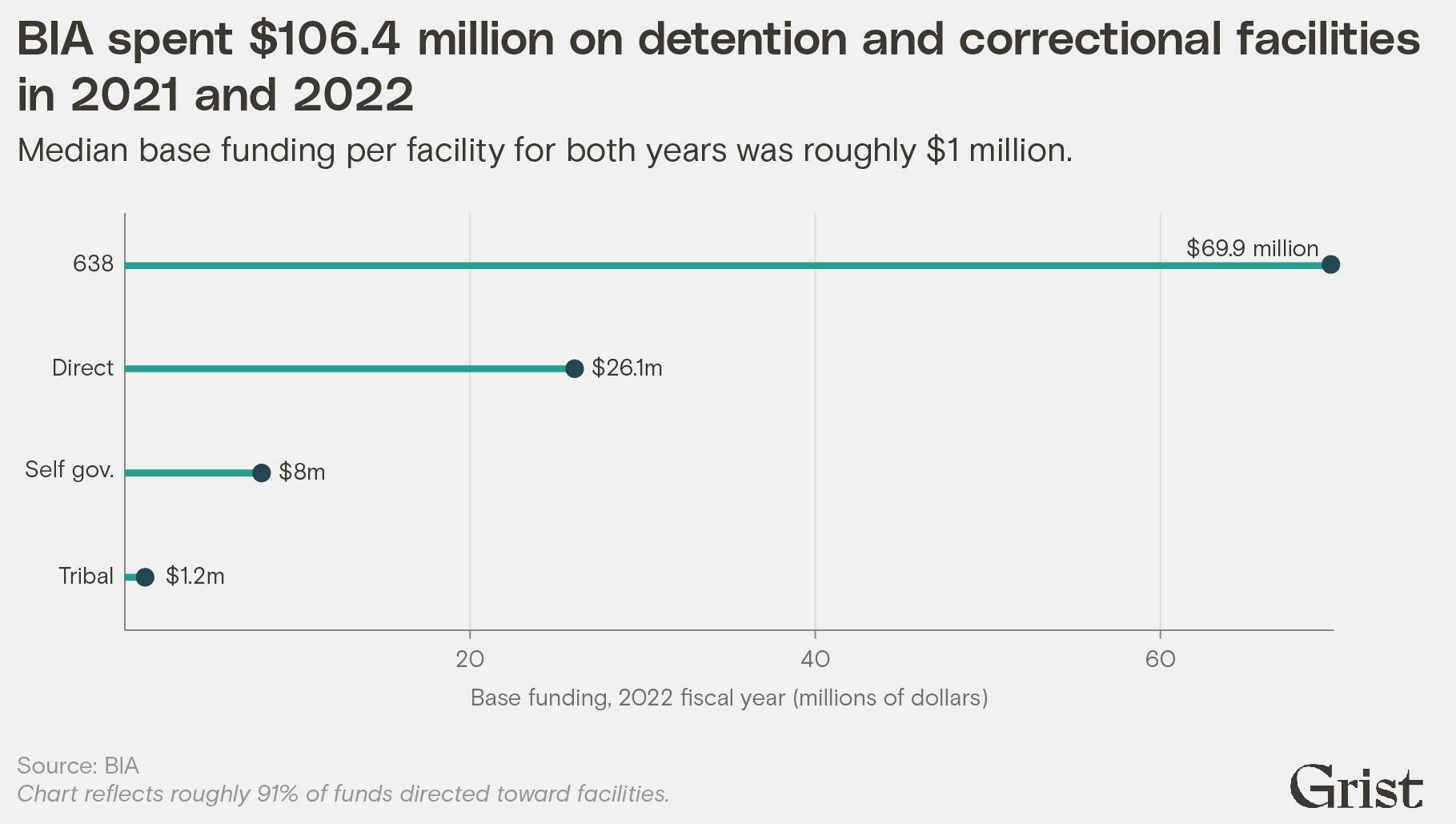
Image: Jessie Blaeser/Grist
Of the 27 tribal jails visited by Department of Interior investigators in 2004, 10 were run directly by the BIA while 17 were 638 programs, run by local tribes with a combination of federal and tribal funding. Investigators noted that, in general, the 638 facilities were better managed.
In 2022, after NPR’s reporting, the BIA announced reforms to its corrections program, including updated policies for death investigations, revised processes for cell checks, and improvements to staff training.
But Ed Naranjo, a member of the Confederated Tribes of the Goshute Reservation and a former supervisory special agent for the BIA who helped spark the 2004 investigation, says that not enough has been done since the report’s release. “You got people sitting in D.C. in these offices, and they don’t really give a damn about what’s going on in the field,” Naranjo said. “It seems that they just neglect what’s going on as long as nobody makes any waves, and everything’s supposedly fine.”
In a statement, a BIA spokesperson wrote, “In accordance with procedures developed in partnership with Tribes, facility conditions are monitored quarterly to assess facility needs and to prioritize projects to be completed with available funding.” The BIA also wrote that it does not track how much funding tribes contribute toward detention facilities or whether optimal staffing levels are fulfilled. In response to a question about how many functioning HVAC systems there are in tribal detention centers, the spokesperson wrote that there is no centralized monitoring program relating to the maintenance of HVAC systems, but that “essential airflow systems are closely monitored and maintained by Tribal/BIA maintenance crews.”
For 2023, the BIA has budgeted over $15 million for “public safety and justice facilities improvement and repair,” roughly two-thirds of which is earmarked for “minor improvement and repair,” which can include accessibility updates and disposal of property. Just $1 million is designated for environmental projects like managing air and water quality, which comes to just over $12,000 per facility if divided equally among the 81 facilities listed by the BIA.
In its 2023 budget, the BIA plans for the construction of nine new detention centers, including three 638 facilities, most of which are replacing existing facilities. According to the BIA’s 2023 Budget Justifications report, without these new facilities, “Employee and Inmate safety will also continue to be impaired by inadequate facilities incapable of addressing modern detention requirements.”
Derrick Marks, a Yankton Sioux Council Member, says one of the biggest issues with relying on federal funding is that money is tied to the whims and policies of the administration in power. “As Native Americans, the less that we can have other people making decisions on our behalf, the better it is,” said Marks.
The Yankton jail, located in Wagner, South Dakota, less than 15 miles north of the Nebraska border, is currently run directly by the BIA. While Marks says he would prefer the tribe manage the jail itself, he’s hesitant about pushing for a shift to a 638 contract. Although 638 facilities receive BIA funding, Marks says that the amount provided would not be sufficient to properly run the jail and the tribe simply doesn’t have the resources to fill in the gaps. Beyond day-to-day upkeep and administration, preparing for a more extreme climate future comes with its own hurdles. “I don’t know where the next administration is going to go with this stuff, with climate change,” Marks said. “It’s just so up in the air.”
Some Indigenous activists, however, are not convinced that tribal management and increased funding are real solutions. Some, like Brandon Benallie, who is Diné and a member of the K’é Infoshop, a Diné Anarchist and Communist Collective, believe that jails are part of a punitive justice system that has never worked for Indigenous people. Instead of spending millions on upgrading tribal jails, tribes should be spending money on resources to build culturally appropriate treatment centers for substance use disorders and working to address the root causes of crime, argues Benallie.
“We can’t just call everything an experiment of sovereignty when it harms our people,” said Benallie. Later in the interview, he explained, “We’re looking for short-term or nearsighted solutions to handle things that take an immense amount of time and responsibility.”
Experts and tribal officials who Grist spoke to for this story underscored the obligations the federal government owes to tribes but routinely violates — legal agreements between Indigenous nations and the United States that exchanged large swaths of land for guarantees like education, health care, and financial support.
“The feds can always help out more,” Urbina, the public defender at Pueblo of Laguna, said. “They have a trust obligation to the Native American tribes, and I think they can always do a better job, considering the historical trauma, the stuff that’s been done by the federal government to these tribes.” Officials from Laguna wrote to Grist that they need additional resources from the federal government for the detention facility and regularly request additional funding for staff and facility improvements.
In lieu of relying on the United States, though, tribes have adapted. When heat reached dangerous levels in Arizona this past summer, tribal council member Grey said Salt River detainees were kept inside, safe in indoor recreation areas with air-conditioning, tablets, and televisions. According to Grey, the center is able to avoid infrastructure problems found in some other tribal jails because it is a self-governance facility funded by the tribe, in part through tribally operated casinos. In addition to infrastructure, funding goes to initiatives such as language classes for detainees and culturally appropriate programs that focus on rehabilitation.
“We’re blessed because we’re able to have our own HVAC people on staff dedicated to the facility,” said Grey. “A lot of communities aren’t that blessed to have that.”
To help close the gap and protect some of the country’s most vulnerable prisoners, advocates say that the federal government needs to uphold its obligations.
“Tribes need to raise a lot more hell about this whole thing, demand things,” said Naranjo. “I don’t think a lot of tribes realize they have a voice. If they unify and get together, they can make some changes and get things done.”
Additional research by Precious Ivy Molina, Liz Barry, and Nicholas Shapiro of Carceral Ecologies at UCLA.